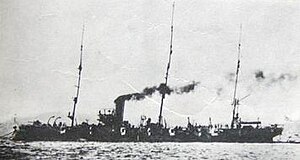Japanese cruiser Chiyoda
 Chiyoda around 1900
| |
| History | |
|---|---|
| Name | Chiyoda |
| Ordered | 1888 Fiscal Year |
| Builder | J & G Thomson (From 1899 John Brown & Company), United Kingdom |
| Laid down | 4 December 1888 |
| Launched | 3 June 1890 |
| Completed | 1 January 1891 |
| Decommissioned | 28 February 1927 |
| Fate | Expended as target 5 August 1927 |
| General characteristics | |
| Type | Cruiser |
| Displacement | 2,439 long tons (2,478 t) |
| Length | 94.49 m (310 ft 0 in) w/l |
| Beam | 12.81 m (42 ft 0 in) |
| Draught | 4.27 m (14 ft 0 in) |
| Propulsion | 2-shaft vertical triple expansion , 6 locomotive boilers, 5,678 hp (4,234 kW) |
| Speed | 19 knots (22 mph; 35 km/h) |
| Complement | 350 |
| Armament |
|
| Armour |
|
Chiyoda (千代田) was a cruiser of the Imperial Japanese Navy, which served in the First Sino-Japanese War, Russo-Japanese War and World War I.
Background
Chiyoda was ordered by the
Design
Chiyoda was a 'belted cruiser' based on a much scaled-down version of the
Service record
With the outbreak of the
After the war, Chiyoda went into
During the
On 28 August 1912, Chiyoda was re-designated as a 2nd-class coastal defense vessel.
During the Siege of Tsingtao in World War I, Chiyoda was part of the Japanese fleet sent to capture the Imperial German Navy base at Tsingtao in Shandong, China.[5] Afterwards, based out of Manila, she took part in Allied patrols of the China coast against German commerce raiders.
On 14 April 1921, Chiyoda was downgraded to a destroyer tender and was used for various odd tasks, including a submarine tender and as a school ship for naval cadets.
Chiyoda was officially decommissioned on 28 February 1927 and sunk as a target during
After its dismantling, the
Gallery
-
c. 1880s
-
In parade flags after the Russo-Japanese War, 1905–1907
Notes
- ^ Laughton, Leonard George Carr; Anderson, Roger Charles (2007). "Chiyoda". The Mariner's Mirror. 93. The Society for Nautical Research: 488.
- ^ Jentsura, Warships of the Imperial Japanese Navy, pages 72
- ^ a b c Chesneau, Conway's All the World's Fighting Ships 1860–1905, pages 231–233
- ^ Davidson, 298–99
- ^ Howarth, The Fighting Ships of the Rising Sun
References
- Chesneau, Roger (1979). Conway's All the World's Fighting Ships 1860–1905. Conway Maritime Press. ISBN 0-85177-133-5.
- Davidson, J. W., The Island of Formosa, Past and Present (London, 1903)
- Evans, David C.; ISBN 0-87021-192-7.
- Gardiner, Robert, ed. (2001). Steam, Steel and Shellfire, The Steam Warship 1815-1905. Chartwell Books, Incorporated. ISBN 0-7858-1413-2.
- Howarth, Stephen (1983). The Fighting Ships of the Rising Sun: The Drama of the Imperial Japanese Navy, 1895-1945. Atheneum. ISBN 0-689-11402-8.
- Jentsura, Hansgeorg (1976). Warships of the Imperial Japanese Navy, 1869-1945. Annapolis, MD: Naval Institute Press. ISBN 0-87021-893-X.
- Milanovich, Kathrin (2006). Jordan, John (ed.). Chiyoda (II): First "Armoured Cruiser" of the Imperial Japanese Navy. Warship 2006. London: Conway's. pp. 126–136. ISBN 1-84486-030-2.
- Roberts, John (ed). (1983). 'Warships of the world from 1860 to 1905 - Volume 2: United States, Japan and Russia. Bernard & Graefe Verlag, Koblenz. ISBN 3-7637-5403-2.
- Roksund, Arne (2007). The Jeune École: The Strategy of the Weak. Leiden: Brill. ISBN 978-90-04-15723-1.
- Schencking, J. Charles (2005). Making Waves: Politics, Propaganda, And The Emergence Of The Imperial Japanese Navy, 1868-1922. Stanford University Press. ISBN 0-8047-4977-9.


